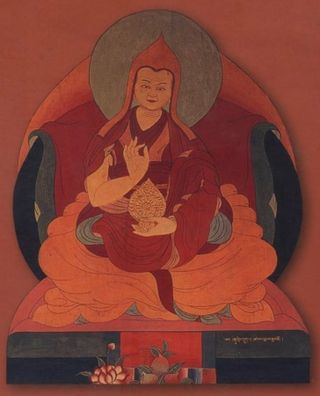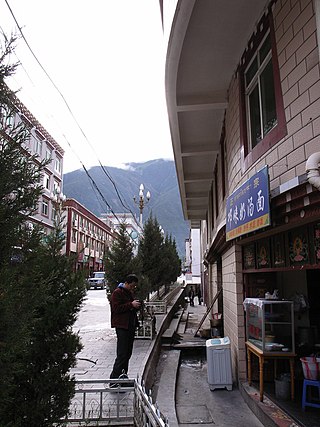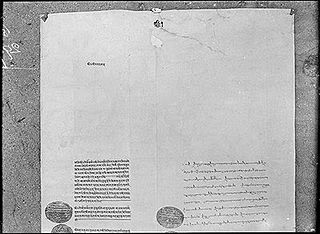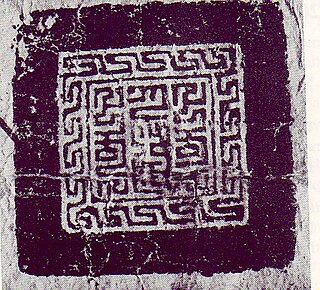Related Research Articles

Dalai Lama is a title given by Altan Khan in 1578 AD at Yanghua Monastery to the foremost spiritual leader of the Gelug or "Yellow Hat" school of Tibetan Buddhism, the newest and most dominant of the four major schools of Tibetan Buddhism. The 14th and incumbent Dalai Lama is Tenzin Gyatso, who lives in exile as a refugee in India. The Dalai Lama is considered to be the successor in a line of tulkus who are believed to be incarnations of Avalokiteśvara, the Bodhisattva of Compassion.

While the Tibetan plateau has been inhabited since pre-historic times, most of Tibet's history went unrecorded until the creation of Tibetan script in the 7th century. Tibetan texts refer to the kingdom of Zhangzhung as the precursor of later Tibetan kingdoms and the originators of the Bon religion. While mythical accounts of early rulers of the Yarlung Dynasty exist, historical accounts begin with the introduction of Tibetan script from the unified Tibetan Empire in the 7th century. Following the dissolution of the empire and a period of fragmentation in the 9th-10th centuries, a Buddhist revival in the 10th–12th centuries saw the development of three of the four major schools of Tibetan Buddhism.

Tsangyang Gyatso was the 6th Dalai Lama. He was an unconventional Dalai Lama that preferred a libertine lifestyle to that of an ordained monk. His regent was killed before he was kidnapped by Lha-bzang Khan of the Khoshut Khanate and disappeared.

The Jokhang, or the Ra sa 'phrul snang gtsug lag khang, or Qoikang Monastery, or Zuglagkang,, is considered the "heart of Lhasa". The Jokhang consists of a Tibetan Buddhist temple, its temple complex, and a Gelug school monastery. Located in Barkhor Square, it was built in c.640 by King Songsten Gampo to house the Jowo Mikyo Dorje, a statue of Akshobhya Buddha, brought to Tibet by his Nepalese queen, Bhrikuti. Another statue, the Jowo Shakyamuni, brought by his Tang Chinese queen Wencheng, is currently housed in the temple and the Jowo Mikyo Dorje is housed in the Ramoche, in Lhasa.

Samye, full name Samye Mighur Lhundrub Tsula Khang and Shrine of Unchanging Spontaneous Presence, is the first Tibetan Buddhist and Nyingma monastery built in Tibet, during the reign of King Trisong Deutsen. Shantarakshita began construction around 763, and Tibetan Vajrayana founder Guru Padmasambhava tamed the local spirits for its completion in 779. The first Tibetan monks were ordained there. Samye was destroyed during the Cultural Revolution then rebuilt after 1988.

Songtsen Gampo, also Songzan Ganbu, was the 33rd Tibetan king of the Yarlung dynasty and he established the Tibetan Empire. As the first of three Dharma Kings of Tibet, he formally introduced Buddhism to Tibet, and built the Jokhang with the influence of his Nepali queen Bhrikuti, of Nepal's Licchavi dynasty. He unified several Tibetan kingdoms, conquered lands adjacent to Tibet, and moved the capital to the Red Fort in Lhasa. His minister Thonmi Sambhota created the Tibetan script and Classical Tibetan, the first literary and spoken language of Tibet.

Ngawang Lobsang Gyatso was the 5th Dalai Lama and the first Dalai Lama to wield effective temporal and spiritual power over all Tibet. He is often referred to simply as the Great Fifth, being a key religious and temporal leader of Tibetan Buddhism and Tibet. Gyatso is credited with unifying all Tibet under the Ganden Phodrang after a Mongol military intervention which ended a protracted era of civil wars. As an independent head of state, he established relations with the Qing empire and other regional countries and also met early European explorers. Gyatso also wrote 24 volumes' worth of scholarly and religious works on a wide range of subjects.

Tri Songdetsen was the son of Me Agtsom, the 38th emperor of Tibet. He ruled from AD 755 until 797 or 804. Tri Songdetsen was the second of the Three Dharma Kings of Tibet, playing a pivotal role in the introduction of Buddhism to Tibet and the establishment of the Nyingma or "Ancient" school of Tibetan Buddhism.
Tritsuk Detsen, better known by his nickname Ralpachen, was the 40th king of the Yarlung Dynasty of Tibet. He reigned after the death of his father, Sadnalegs, in c. 815, and grew the empire to its largest extent. He was murdered by his younger brother Langdarma in 838. Ralpachen is one of Tibet's three Dharma Kings, and referred to as "son of God" in the ancient Tibetan chronicle Testament of Ba.
Tridé Songtsen, better known by his nickname Sénalek Jingyön or Sadnalegs for short, was the youngest son of King Trisong Detsen of Tibet.
Tridé Tsuktsen, nicknamed Mé Aktsom, was the emperor of the Tibetan Empire and the son of Tridu Songtsen and his queen, Tsenma Toktokteng, Princess of Chim. He is usually known by his nickname Mé Aktsom "Bearded Grandfather", which was given to him later in life because he was so hirsute.

Batang Town, officially Xiaqiong Town, is a town in Batang County, Garzê Tibetan Autonomous Prefecture, Sichuan Province, in the China on the main route between Chengdu and Lhasa, Tibet, and just east of the Jinsha River, or Upper Yangtze River. It is at an elevation of 2,700 metres.

Tsepon Wangchuk Deden Shakabpa was a Tibetan nobleman, scholar, statesman and former Finance Minister of the government of Tibet.

The Tibetan Empire was an empire centered on the Tibetan Plateau, formed as a result of imperial expansion under the Yarlung dynasty heralded by its 33rd king, Songtsen Gampo, in the 7th century. The empire further expanded under the 38th king, Trisong Detsen, and expanded to its greatest extent under the 41st king, Rapalchen, whose 821–823 treaty was concluded between the Tibetan Empire and the Tang dynasty. This treaty, carved into the Jokhang Pillar, delineated Tibet as being in possession of an area larger than the Tibetan Plateau, stretching east to Chang'an, west beyond modern Afghanistan.

Tsarong Dasang Dramdul (1888–1959), commonly known mononymously as Tsarong or by his title Tsarong Dzasa, was a Tibetan politician and general in the Tibetan Army. He was a close aide of the 13th Dalai Lama and played an important role in the early twentieth century politics of Tibet. Eager to accelerate economic progression and pursue the modernization of Tibet, Tsarong believed that the old order in Tibet had to be broken by hierarchical reforms to prepare the way for a more modern society which would be compatible with the outside world. In his efforts to build up Tibet's defense systems and relations with European powers as well as to facilitate trade and strengthen the Tibetan currency, he made a series of diplomatic visits to British India. His diplomatic skills came to see him regarded by the British as being, "the most powerful friend of His Majesty's Government in Tibet."

Tibet was a de facto independent state in East Asia that lasted from the collapse of the Qing dynasty in 1912 until its annexation by the People's Republic of China in 1951.

The Treaty of Thapathali was a treaty signed between the Tibetan government of Ganden Phodrang and the Kingdom of Nepal in Thapathali Durbar in Kathmandu, the capital of Nepal, following the Nepal-Tibet War (1855–1856). In January 1856, a representative group of Tibet came to Kathmandu for discussion of the treaty. After a long discussion, the representative group ultimately signed a treaty on 24 March.

Khangchenné Sonam Gyalpo was the first important representative of the noble house Gashi in Tibet. Between 1721 and 1727 he led the Tibetan cabinet that governed the country during the period of Qing rule of Tibet. He was eventually murdered by his peers in the cabinet, which triggered a bloody but brief civil war. The nobleman Polhané Sönam Topgyé came out as the victor and became the new ruling prince of Tibet under the Chinese protectorate.
We Gyaltore Taknye, also known as Wa Taknachen, was the last Lönchen of the Tibetan Empire. In Chinese records, his name was given as Jié Dūnà.

Tibet–India relations are said to have begun during the spread of Buddhism to Tibet from India during the 6th century AD. In 1959, the Dalai Lama fled to India after the failed 1959 Tibetan uprising. Since then, Tibetans-in-exile have been given asylum in India, with the Indian government accommodating them into 45 residential settlements across 10 states in the country, creating the Tibetan diaspora. From around 150,000 Tibetan refugees in 2011, the number fell to 85,000 in 2018, according to government data. Many Tibetans are now leaving India to go back to Tibet and other countries such as United States or Germany. The Government of India, soon after India's independence in 1947, treated Tibet as a de facto independent country. However, more recently India's policy on Tibet has been mindful of Chinese sensibilities, and has recognized Tibet as a part of China.
References
- ↑ "About Dranga Palkye Yongten". mandalas.life. Mandalas Life. Retrieved August 4, 2024.
- ↑ "Tibet Disunity, 9th to 14th century". britannica.com. Encyclopædia Britannica, Inc. Retrieved August 4, 2024.
- ↑ "Historical Facts About Tibet". thus.org. Tibet House US . Retrieved August 4, 2024.